Delicious, delicate, and lean fish is the perfect midweek protein. Unfortunately, fish can become dry, chalky, and unpleasant if overcooked which makes it ideally suited to the sous vide cooking technique. Using this simple cooking method all sorts of fish can be cooked to the perfect level of doneness while retaining all their moisture and perfectly flaky texture. Sous vide adds a layer of control and precision that allows you to prepare any type of fish to the exact level of doneness you prefer.
Here’s how to cook fish using sous vide.
1. Catfish Cooking Temperatures and Times
2. Cod Cooking Temperatures and Times
3. Haddock Cooking Temperatures and Times
4. Halibut Cooking Temperatures and Times
5. Mahi Mahi Cooking Temperatures and Times
6. Monkfish Cooking Temperatures and Times
7. Salmon Cooking Temperatures and Times
8. Swordfish Cooking Temperatures and Times
9. Tuna Cooking Temperatures and Times
10. Ingredients and Tools
11. Preparation
12. Suvie Directions
13. Immersion Circulator Directions
14. Finishing
15. Recipes
16. FAQs
Catfish

Far being the exclusive domain of Cajun and Creole cuisine, catfish is enjoyed by a wide range of cultures in numerous countries around the world. The popularity is well-founded because well-cooked catfish has a delicious, mild, and subtle flavor and a wonderfully moist texture. While it’s most commonly enjoyed deep fried or blackned cajun-style in the USA, sous vide is a great way to cook this fish at home.
| Temperature | Time | Result |
| 125°F* | 30-60 minutes | Medium, firm, moist, and flaky |
| 130°F | 30-60 minutes | Well done but still moist, flaky |
Catfish is a thin fish, so we don’t recommend cooking it for longer than 30 minutes.
Cod

Cod is a white fish with a pleasantly firm and flaky texture and mild flavor. The subtle taste of cod makes it extremely versatile as it pairs well with a variety of sides and sauces.
| Temperature | Time | Result |
| 125°F* | 30-60 minutes | Tender, slightly flaky |
| 130°F | 30-60 minutes | Medium, firm, moist, and flaky |
| 135°F | 30-60 minutes | Well done but still moist, flaky |
Haddock

Haddock is extremely popular in the United Kingdom where it is a staple of fish and chips takeaways. Cold smoking haddock is also a popular preservation technique similar to smoked salmon. Smoked or unsmoked, haddock, like all white fish, is ideally suited to precise sous vide cooking.
| Temperature | Time | Result |
| 125°F* | 30-60 minutes | Tender, slightly flaky |
| 130°F | 30-60 minutes | Medium, firm, moist, and flaky |
| 135°F | 30-60 minutes | Well done but still moist, flaky |
Halibut

Lean, full-flavored, and surprisingly delicate, halibut is a perfect main act in a healthy weeknight dinner. Like salmon and tuna, halibut is a fish that greatly benefits from sous vide cooking.
| Temperature | Time | Result |
| 125°F* | 30-60 minutes | Rare, tender, slightly flaky |
| 130°F | 30-60 minutes | Medium, firm, moist, and flaky |
| 135°F | 30-60 minutes | Well done but still moist, flaky |
Mahi Mahi

Lean, moist, and with a delicate, not overly fishy flavor, mahi mahi is a versatile centerpiece to your midweek meal. The leanness of mahi mahi is a bit of a double-edged sword as it can become overly dry if overcooked. Fortunately, cooking this fish using sous vide is an absolute breeze.
| Temperature | Time | Result |
| 125°F* | 30-60 minutes | Rare, tender, slightly flaky |
| 130°F | 30-60 minutes | Medium, firm, moist, and flaky |
| 135°F | 30-60 minutes | Well done but still moist, flaky |
Monkfish

Monkfish has a fairly mild and meaty taste so it works best when paired with bold and robust flavors. It’s known for its unusually dense and firm flesh that has a similar texture to large shellfish, as a result, it is often referred to as the “poor man’s lobster.” Monkfish can become rubbery and unpleasant if overcooked. Fortunately, cooking monkfish using the precise sous vide method keeps the fish tender while bringing out the delicate flavors.
| Temperature | Time | Result |
| 120°F* | 20-30 minutes | Slightly firm and very moist |
| 125°F* | 20-30 minutes | Medium, firm but still moist |
| 130°F | 20-30 minutes | Well done, very firm |
Salmon

Packed with flavor, nutritious, and oh-so-versatile salmon really is a wonderful fish. Despite its obvious benefits, however, salmon also has a reputation for being difficult to cook correctly. Fortunately, Suvie and the sous vide cooking method takes all the guesswork out of preparing this famously fickle fish. With the precision and control of sous vide and Suvie, dry salmon and a smelly kitchen becomes a thing of the past.
| Temperature | Time | Result |
| 125°F* | 30-60 minutes | Rare, tender, moist, and flaky |
| 130°F | 30-60 minutes | Medium, firm, moist, and flaky |
| 135°F | 30-60 minutes | Well done but still moist |
Swordfish

Meaty, succulent, and with a pleasantly firm texture, swordfish is the perfect fish for people who don’t like fish. As is the case with all fish, swordfish is prone to overcooking and greatly benefits from sous vide cooking.
| Temperature | Time | Result |
| 125°F* | 30-60 minutes | Rare, tender, slightly flaky |
| 130°F | 30-60 minutes | Medium, firm, moist, and flaky |
| 135°F | 30-60 minutes | Well done but still moist, flaky |
Tuna

Wonderfully meaty and firm seared tuna is an absolute treat, unfortunately, it’s also a tricky food to get right. Tuna is a notoriously delicate fish that can be easily ruined by conventional cooking methods.
| Temperature | Time | Result |
| 120°F* | 30-45 minutes | Firm and moist |
| 125°F* | 30-45 minutes | Firm and less moist |
| 130°F | 30-45 minutes | Flaky and firm |
*Please note that some of these temperatures are lower than what the FDA recommends. Consuming raw or undercooked meats, poultry, seafood, shellfish, or eggs may increase your risk of food-borne illness.
Ingredients and Tools
- Fish
- Salt
- Pepper
- Vegetable oil or butter
- Lemon (optional)
Equipment
- Suvie or immersion circulator
- A large pot (if using an immersion circulator)
- Vacuum sealer and bags or Freezer safe sealable plastic bags
Preparation
If you’re using an immersion circulator, pre-heat your water bath to the desired temperature
Pat fish dry and season with salt and pepper. You can dry-brine the fish for 30 minutes prior to cooking as well.
Place fish in a plastic bag, add oil or butter and optional lemon juice and vacuum-seal.
Follow our guide if you are using the water displacement method.
Suvie Directions
Place the bag into the Suvie protein pan and cover with water. Place in Suvie and use the following settings:

Suvie Cook Settings
Bottom Zone: Sous Vide at 120-135°F for 30 to 60 minutes (based on desired doneness)
Top Zone: Sous Vide at 120-135°F for 30 to 60 minutes (based on desired doneness)
Once the cook is finished, remove the bag from the water bath or pan.
Very carefully remove the fish from the bag and pat dry with a paper towel.
Immersion Circulator Directions
Once the immersion circulator has reached the required temperature, gently lower the plastic bag into the water. Ensure that the plastic bag is not touching the metal rod of the immersion circulator.
Once the cook is finished, remove the bag from the water bath. Carefully remove the fish from the bag and pat dry with a paper towel.
Finishing
Heat some vegetable oil or butter in a stainless steel or nonstick skillet over medium or high heat. Carefully place the fish skin side down (if applicable) in the hot pan. Sear for between 30-60 seconds without flipping. Flip and cook the other side for another 30-60 seconds.
Remove from heat and serve immediately.
Recipes
White Fish with Herb Butter over Spinach

Kerala Fish Curry

Cod with Kale and Beans

Cod Pozole
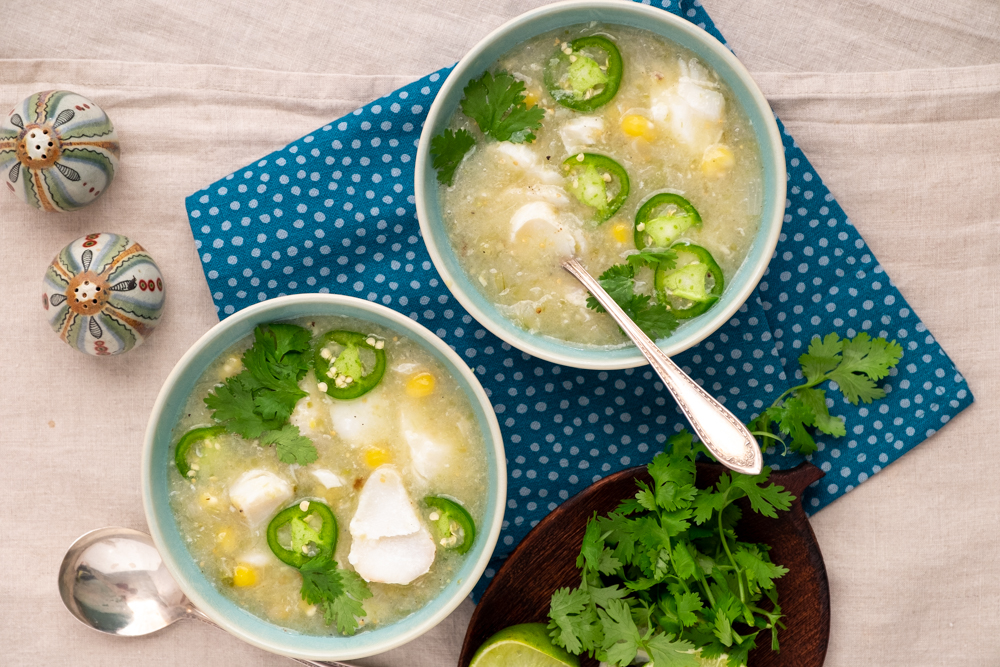
Mahi Mahi with Mango Salsa
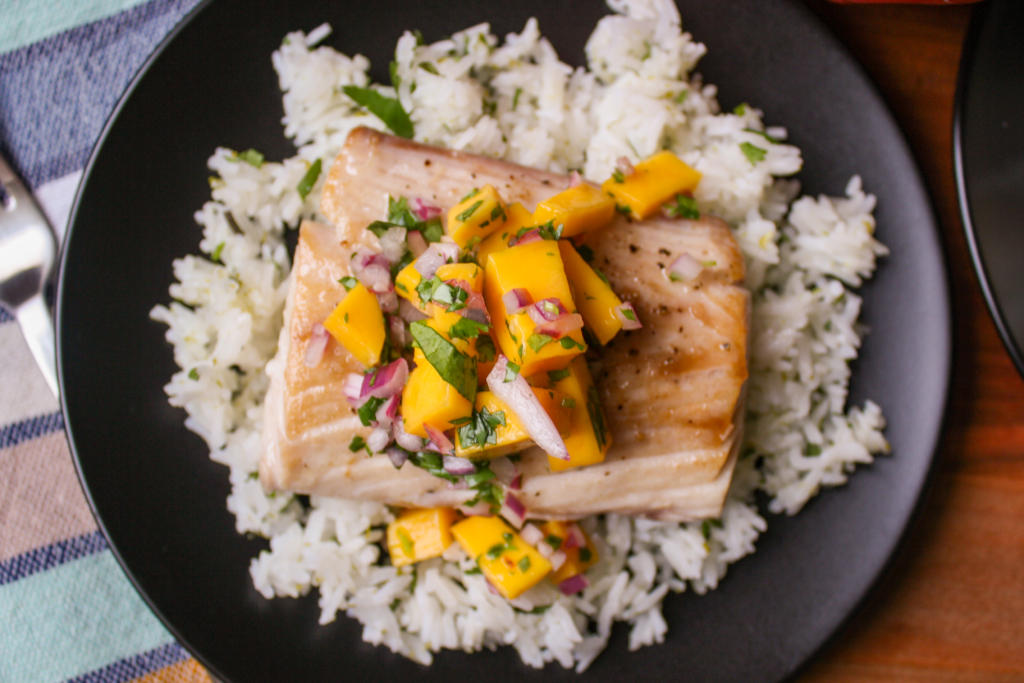
Seared Swordfish with Gremolata and Sugar Snap Peas over Orzo

Miso-Tahini Halibut with Zucchini Salad
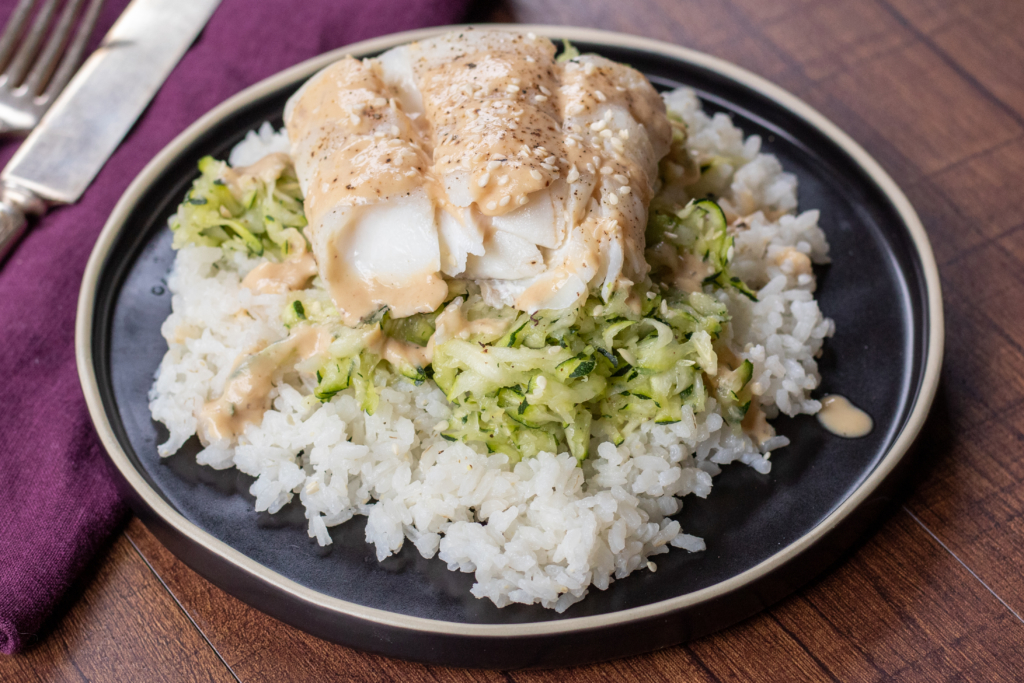
Halibut with Cilantro-Lime Butter

Tomato-Basil Halibut with Wild Rice and Green Beans
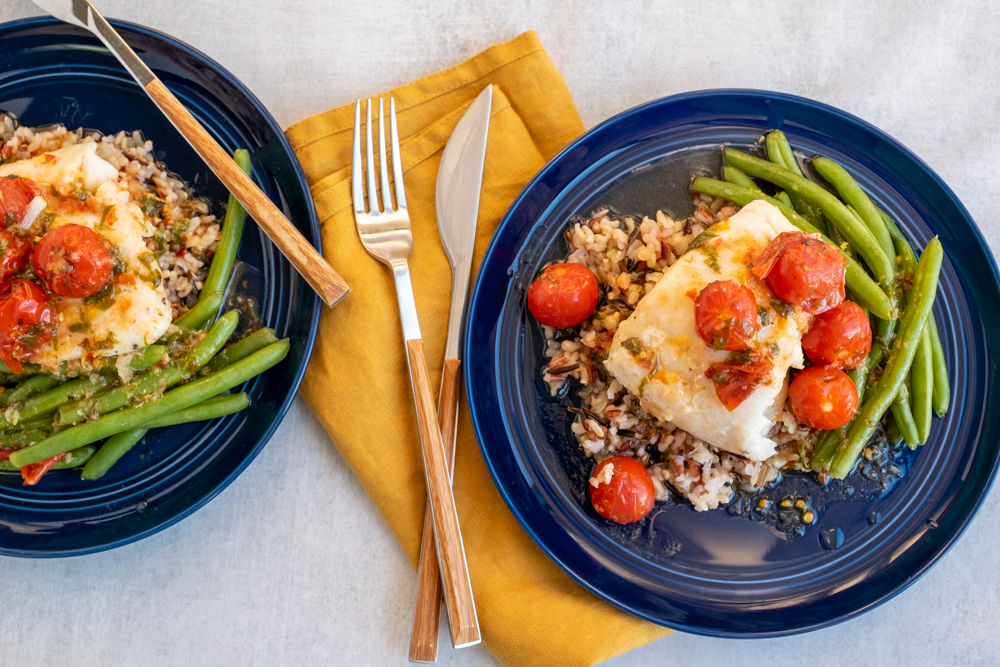
Salmon and Asparagus Orecchiette

Salmon with Lentils

Pecan Crusted Salmon

Togarashi Salmon

Miso-Glazed Salmon
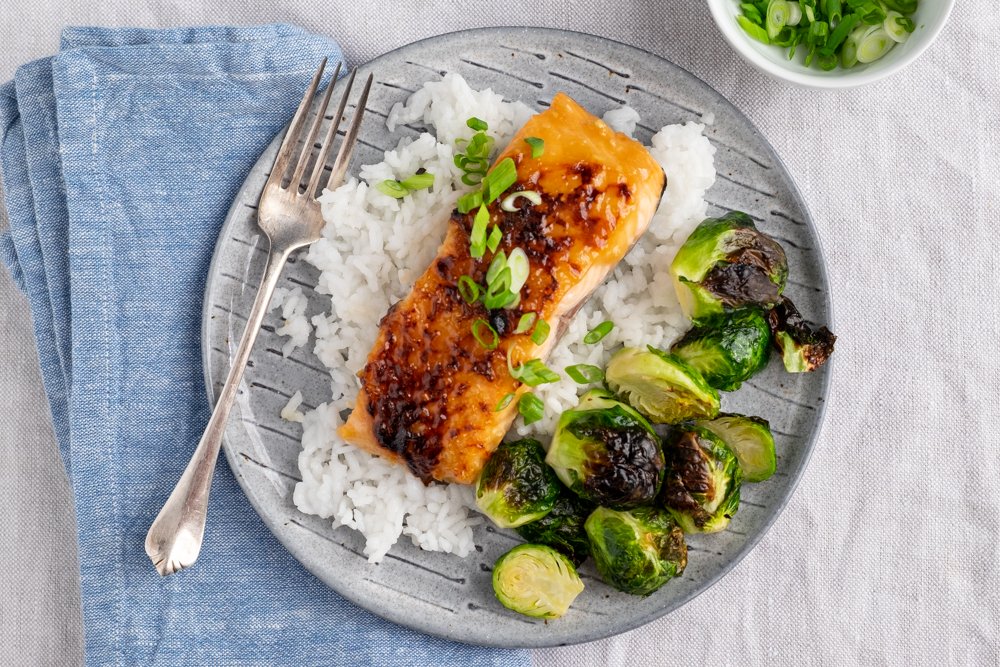
Honey Lemon Salmon with Avocado and Tomato

Salmon with Herb Caper Topping

Salmon with Roasted Fennel and Radish

Honey Mustard Salmon

Ponzu Salmon

Salmon with Dill Sauce

Sesame-Crusted Salmon

Salmon and Farro Salad

Tarragon-Panko Salmon with Swiss Chard and Farro

Tuna Nicoise

FAQs
Are the cooking temperatures safe?
Our recommended cooking temperatures for Sous vide and Suvie are lower than what the USDA recommends, however, cooking times and temperatures are long enough and high enough for “pasteurization” to make your food safe. The USDA recommendations indicate the temperature needed to instantly kill food pathogens. By cooking for a longer time at a lower temperature we are able to achieve the same effect. However, high-risk populations should use extra caution when preparing foods below the USDA recommended temperatures.
Can I use any type of plastic bag?
You can, however, make sure that they are made from polyethylene. Some branded bags are made using polyethylene which is a BPA and dioxin free plastic that can safely handle sous vide cooking temperatures up to 190°F. Some generic branded plastic bags are made using cheaper polyvinyl chloride (PVC) which cannot handle high temps and contains chemicals that can leach into food.
What’s the chalky white substance on the exterior of the fish?
You may notice a white film forms on the exterior of your fish after it has cooked. This is albumin, a water-soluble protein that coagulates when heated and is completely safe to eat. It’s the same protein you find in egg whites and milk. Simply rinse or carefully brush off the albumin with a paper towel to remove.
Note: Adding oil to the sous vide bag should help to inhibit the development of the albumin.
Should I use skin-on or skinless fish?
This method will also work with either however, we recommend frying the skin for between 1 and 2 minutes to get it crisp. Also, if you only have skin-on fish and want to remove the skin wait until after the sous-vide process. The cooking process will break down the connective tissue making it easier to remove the skin before serving.
Where can I get vacuum sealed proteins?
If you don’t want to fuss with vacuum sealers and ziplock bags you can skip the store and order the Suvie Protein Box. Just put together your ideal combination of preseasoned, portioned, and vacuum-packed high-quality meat, poultry, or fish. We deliver it to you frozen in a carefully-packed box.
Do I need to brine the fish before cooking?
Fish often benefits from a short 30-minute dry-water brine before cooking. However, thanks to the precision and control of sous vide this step is unnecessary.



